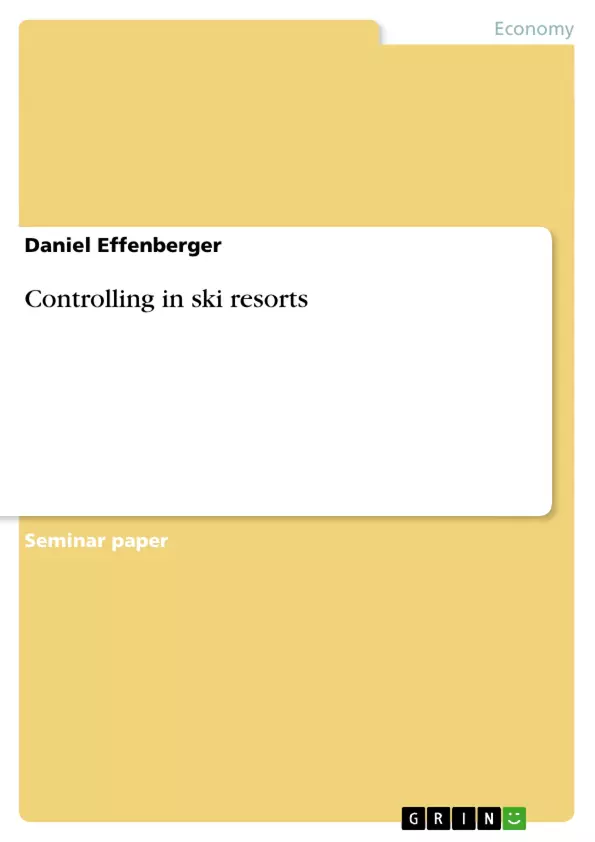In the last 50 years winter sport became a major economical size in mountain regions, especially in the European Alps and the Rocky Mountains. Until 1979 a lot of new ski resorts were developed. At the beginning of the 80´s the politicians intervened in the wild extension in the Alps and organized the development of this natural space. The rapid expansion was finished.1 In the 80´s and 90´s, the enterprises began to integrate further parts of the value chain. Pure lift operators became big ski resort companies. From the beginning of the 90´s the growth of winter sportsmen stagnated.2 In total there are about 32 million skiers in Europe.3 Nowadays it is nearly impossible to open new resorts. Consequently the ski resort companies are more asked to improve their services, make up combinations with other resorts, built up co- operations or downsize the companies to compete with other ski resorts in the mountains. This market is really hard battled and the suppliers try to find their niches like family-, pure sport- or snowboard resorts. They started to concentrate on their core competencies at the end of the 90´s and invested huge amounts of money to upgrade the important transport possibilities like chair lifts or gondolas in the whole resorts. Most of the smaller and middle sized ski resorts work with deficit.4 This made it extremely important in the 90´s for businesses to introduce new divisions in the organizational structure to control and support the management.5 Nowadays only about 50 percent of the ski resorts know Controlling as a division of the management; therefore they often invest money without knowing the affects of it.6 The increasing importance of Controlling in ski resorts is shown by the fact that PwC Switzerland has got an own team for this subject. Due to the shortness of this seminar paper there is only a coarse outline of the subject with a focal point on medium and big sized companies represented with it.
Inhaltsverzeichnis (Table of Contents)
- 1. Introduction
- 2. Features of ski resorts
- 3. Structure of the controlling in ski resorts
- 3.1 Strategic and Operative Controlling
- 3.1.1 Strategic Controlling
- 3.1.2 Operative Controlling
- 3.2 Controlling in the organizational structure
- 3.3 Controlling process in ski resorts
- 3.3.1 Timing
- 3.3.2 Planning course in ski resorts
- 3.4 Costing and revenue accounting
- 3.4.1 Cost sections
- 3.4.2 Cost system
- 3.4.3 Revenue accounting
- 3.1 Strategic and Operative Controlling
- 4. Controlling-tools
- 4.1 Marginal costing
- 4.2 Activity based costing
- 4.3 Capital budgeting
- 4.4 Benchmarking
- 4.5 Yield management
- 4.6 Further tools
- 5. Information resource Management
- 5.1 Electronic Data Processing (EDP)
- 5.2 Reporting and ratios
Zielsetzung und Themenschwerpunkte (Objectives and Key Themes)
This paper explores the application of controlling principles in the context of ski resorts. The study aims to provide a comprehensive understanding of the specific challenges and opportunities associated with controlling activities in this unique industry sector. The paper emphasizes the significance of strategic and operative controlling in optimizing operational efficiency and achieving long-term success within ski resorts.
- Strategic and Operative Controlling in Ski Resorts
- Controlling Process in Ski Resorts
- Costing and Revenue Accounting in Ski Resorts
- Controlling Tools and Techniques
- Information Resource Management in Ski Resorts
Zusammenfassung der Kapitel (Chapter Summaries)
- Chapter 1: Introduction This chapter sets the stage for the study by introducing the topic of controlling in ski resorts and outlining the key objectives of the paper.
- Chapter 2: Features of ski resorts This chapter focuses on defining the characteristics of ski resorts as unique business entities within the tourism sector. The analysis highlights the specific factors that make controlling in ski resorts distinct from other industries.
- Chapter 3: Structure of the controlling in ski resorts This chapter delves into the organizational structure of controlling within ski resorts, examining both the strategic and operative aspects of controlling. The chapter discusses the implementation of controlling processes within the organizational framework and provides insights into the various stages of controlling activity.
- Chapter 4: Controlling-tools This chapter explores the application of various controlling tools and techniques that are specifically relevant to the context of ski resorts. The chapter examines the use of tools such as marginal costing, activity-based costing, capital budgeting, benchmarking, and yield management. The potential benefits and limitations of each tool in optimizing controlling activities within ski resorts are also explored.
- Chapter 5: Information resource Management This chapter examines the role of information technology and data management in supporting effective controlling practices within ski resorts. The chapter explores the significance of electronic data processing (EDP) and the use of reporting and ratios in providing essential insights for informed decision-making.
Schlüsselwörter (Keywords)
This paper focuses on the core concepts of controlling, specifically within the context of ski resorts. Key terms include: strategic controlling, operative controlling, controlling process, cost accounting, revenue accounting, controlling tools, benchmarking, yield management, information resource management, and electronic data processing (EDP).
- Citation du texte
- Daniel Effenberger (Auteur), 2004, Controlling in ski resorts, Munich, GRIN Verlag, https://www.grin.com/document/35725



